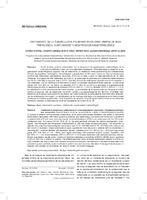Please use this identifier to cite or link to this item:
http://sgc.anlis.gob.ar/handle/123456789/1407| Title: | Tratamiento de la tuberculosis pulmonar en un área urbana de baja prevalencia. Cumplimiento y negativización bacteriológica | Other Titles: | Treatment of pulmonary tuberculosis in a low-prevalence urban area. Compliance and sputum conversion | Authors: | Stoffel, Carina Lorenz, Rosana Arce, Marta Rico, Marina Fernández, Liliana Imaz, María Susana |
Keywords: | Tuberculosis Pulmonar;Terapéutica | Issue Date: | 2014 | Journal: | Medicina (Buenos Aires) | Abstract: | Several factors could be responsible for a delay in bacteriological conversion of sputum in patients with pulmonary tuberculosis (pTB) even under proper treatment. We aimed to determine those factors associated with follow-up test compliance and bacteriologic conversion at month two of treatment in patients with pTB who were receiving directly controlled treatment (DOT) in an urban area with low TB burden (notification rate: 14.9 cases/100 000, 2010-2011). We retrospectively analyzed the clinical, demographic, radiological, microbiological and therapeutic characteristics of 196 new smear-positive pTB cases. The proportion of patients who underwent bacteriological examination was 79.1% (155/196) and 74.7% (121/162) at the second and last month of treatment. Smear examinations were significantly more frequent in patients with co-morbidities or receiving DOT in health facilities with laboratory access. Diabetes (OR 17.4, 95% CI 2.0 - 27.0) and high smear grade (OR 13.8, 95% CI 1.8 - 108.0) were highly associated with persistent positive smears. Cavitation (OR 4.6, 95%, CI 1.1 - 20.5) and diabetes (OR 3.3, 95% CI 1.1 - 10.5) were associated with persistent positive cultures. Smear examination results at two months of treatment indicated a sensitivity of 63.9% (23/36) and a specificity of 82.4% (98/119) in relation to culture. The limited predictive value of smear examination relative to culture results indicated the need to find other markers for sputum conversion. Identification of risk factors associated with persistent sputum positivity could contribute to patient care and resource allocation. Prolonged infectiousness in patients with diabetes could indicate the need to review TB control strategies. |
Description: | Fil: Stoffel, Carina. Programa de Enfermedades Respiratorias y Tuberculosis de Santa Fe, Ministerio de Salud de la Provincia de Santa Fe; Argentina Fil: Lorenz, Rosana. ANLIS Dr.C.G.Malbrán. Instituto Nacional de Enfermedades Respiratorias; Argentina. Fil: Arce, Marta. Hospital Provincial Gumersindo Sayago, Ministerio de Salud de la Provincia de Santa Fe; Argentina. Fil: Rico, Marina. Hospital Provincial Gumersindo Sayago, Ministerio de Salud de la Provincia de Santa Fe; Argentina Fil: Fernández, Liliana. Hospital Provincial Gumersindo Sayago, Ministerio de Salud de la Provincia de Santa Fe; Argentina Fil: Imaz, María Susana. ANLIS Dr.C.G.Malbrán. Instituto Nacional de Enfermedades Respiratorias; Argentina. |
URI: | http://sgc.anlis.gob.ar/handle/123456789/1407 | ISSN: | 0025-7680 | Rights: | Creative Commons Attribution 4.0 International License |
| Appears in Collections: | Publicaciones INER |
Files in This Item:
| File | Description | Size | Format | |
|---|---|---|---|---|
| 24561834.pdf | Artículo en Español | 410.83 kB | Adobe PDF |  View/Open |
Page view(s)
133
checked on Jan 14, 2026
Download(s)
36
checked on Jan 14, 2026
Google ScholarTM
Check
This item is licensed under a Creative Commons License


